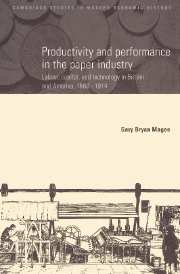 Productivity and Performance in the Paper Industry
Productivity and Performance in the Paper Industry Book contents
- Frontmatter
- Contents
- List of figures
- List of tables
- Acknowledgements
- List of abbreviations
- Introduction
- 1 Background
- 2 Technological change
- 3 Performance
- 4 Rags, esparto, and wood: entrepreneurship and the choice of raw materials
- 5 The Anglo-American labour productivity gap
- 6 Unions and manning practices in Britain and America
- 7 Raw materials, women, and labour-saving machinery: the Anglo-American gap, 1860–1890
- 8 Technological divergence: the Anglo-American gap, 1890–1913
- 9 Free trade and paper
- Conclusion
- Bibliography
- Index
7 - Raw materials, women, and labour-saving machinery: the Anglo-American gap, 1860–1890
Published online by Cambridge University Press: 16 March 2010
- Frontmatter
- Contents
- List of figures
- List of tables
- Acknowledgements
- List of abbreviations
- Introduction
- 1 Background
- 2 Technological change
- 3 Performance
- 4 Rags, esparto, and wood: entrepreneurship and the choice of raw materials
- 5 The Anglo-American labour productivity gap
- 6 Unions and manning practices in Britain and America
- 7 Raw materials, women, and labour-saving machinery: the Anglo-American gap, 1860–1890
- 8 Technological divergence: the Anglo-American gap, 1890–1913
- 9 Free trade and paper
- Conclusion
- Bibliography
- Index
Summary
In chapter 5 it was found that between 1860 and 1890 the observed two-to-one labour productivity gap between the American and British paper industries was unlikely to have had its explanation in the technological supremacy of the former over the latter. On the contrary, the data available suggest that, if anything, in this regard the British industry at this time was performing better. The source of the problem, rather, appeared to have been the general overmanning of British mills. To many the obvious culprit for such a practice was the greater agitation and resistance to change of British workers of the mid- and late Victorian era. In chapter 6, however, this possibility for the paper industry at least was discounted. To what then can we attribute this apparent overmanning? The aim of this chapter is to tackle this question. The answer it gives sees the overmanning of British mills as the result of two factors: each country's choice of raw material and the greater prevalence of labour-saving machinery in the United States. In both instances it is argued that the America's choice was conditioned by its distinct history and resource and factor endowments. Together these choices caused the labour requirements of British and American mills, especially with regard to women, to diverge from the mid-century; a divergence that continued until 1890. The first section in this chapter concerns itself with the choice of raw materials in the United States in the second half of the nineteenth century; the second considers how these choices affected labour requirements in the mill; while the last deals with the pervasiveness of labour-saving devices in the American industry.
- Type
- Chapter
- Information
- Productivity and Performance in the Paper IndustryLabour, Capital and Technology in Britain and America, 1860–1914, pp. 174 - 195Publisher: Cambridge University PressPrint publication year: 1997


